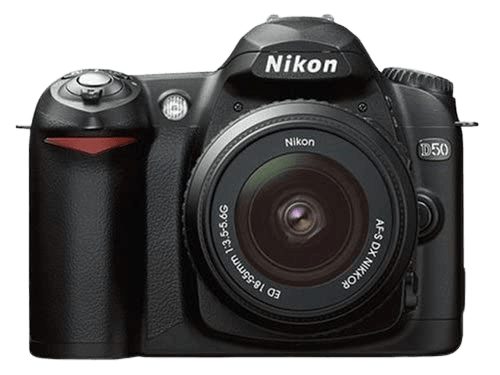Nikon D40 vs D50 Comparison
Nikon D40

Nikon D50

The Nikon D40 and the Nikon D50 are both DSLR cameras with identical scores of 28/100. Both cameras were released in the mid-2000s, with the D40 announced on November 16, 2006, and the D50 on April 20, 2005. They share similarities in camera type and scores, but there are differences in specifications that set them apart.
The Nikon D40 is lighter, weighing 522g compared to the D50’s 620g, and is smaller in size with dimensions of 124 x 94 x 64mm. This makes the D40 more portable and easier to handle. Additionally, the D40 has a lower launch price of $400, making it more affordable than the D50’s launch price of $1000.
On the other hand, the Nikon D50 is larger with dimensions of 133 x 102 x 76mm, which may provide a more comfortable grip for some users. Despite its higher launch price, the D50 has been on the market longer, which could possibly result in a lower current price.
Taking these specifications into account, the Nikon D40 stands out as a more affordable and portable option, while the Nikon D50 may cater to those who prefer a larger camera body.
Nikon D40 vs D50 Overview and Optics
The Nikon D50 wins in the optics comparison with a score of 34/100, while the Nikon D40 scores 33/100. Both cameras share several specifications, including 6-megapixel resolution, 2.5 shooting speed, CCD sensor type, Nikon Image processing engine, APS-C sensor size, Nikon F DX lens mount, and the absence of image stabilization.
The D50’s advantage lies in its slightly higher optics score, which is 34/100 compared to the D40’s 33/100. This difference is minimal, but it gives the D50 a small edge over the D40. Additionally, the D50 has a DXOMARK sensor score of 55, which is one point higher than the D40’s score of 56. This indicates that the D50 might produce slightly better image quality than the D40.
On the other hand, the D40 is not without its merits. Despite having a marginally lower optics score, the camera still offers the same 6-megapixel resolution, 2.5 shooting speed, and CCD sensor type as the D50. This means that the D40 is capable of producing similar image quality to the D50, albeit with a slightly lower DXOMARK sensor score.
Given the minimal difference in optics scores and the shared specifications between the Nikon D40 and D50, both cameras are suitable for photographers looking for a reliable and efficient camera. The D50 may be the winner in this comparison, but the D40 remains a solid option for those seeking a camera with similar features and performance. Ultimately, the choice between the two cameras will depend on the individual’s preferences and specific photography needs.
Nikon D40 vs D50 Video Performance
When examining the video capabilities of the Nikon D40 and Nikon D50, it is important to note that both cameras lack video functionality. The absence of video recording does not affect the overall quality of the cameras, but it is a feature that some users may find lacking.
In summary, neither the Nikon D40 nor the Nikon D50 offer video capabilities. This information is crucial for potential buyers who prioritize video recording in their camera selection. Despite the absence of video functionality, both cameras have their strengths in other areas, such as general specifications and optics.
Nikon D40 vs D50 Features and Benefits
The Nikon D40 wins in the features comparison with a score of 17/100, while the Nikon D50 scores 10/100. Both cameras share some common specifications, such as the absence of a touchscreen, flip screen, GPS, and Bluetooth.
The Nikon D40 outperforms the D50 in terms of screen size and resolution. The D40 features a 2.5-inch screen with a resolution of 230,000 dots, providing a clearer and larger display for users. This advantage allows for better image preview and easier menu navigation, contributing to its higher feature score.
On the other hand, the Nikon D50 has a smaller 2-inch screen with a lower resolution of 130,000 dots. However, the D50 surpasses the D40 in one aspect: it has WIFI capability. This feature enables users to transfer images wirelessly to compatible devices, making it more convenient for sharing and backing up photos.
Despite its lower feature score, the Nikon D50’s WIFI capability may be a valuable asset to some photographers who prioritize wireless connectivity. In contrast, the Nikon D40’s larger and higher-resolution screen offers a more enjoyable user experience for those who value image preview and menu navigation.
Considering the differences in features, the Nikon D40 is a better option for photographers who prioritize screen size and resolution, while the Nikon D50 is suitable for those who value wireless connectivity. Ultimately, the choice between these two cameras depends on the individual’s preferences and priorities.
Nikon D40 vs D50 Storage and Battery
The Nikon D50 outperforms the Nikon D40 in storage and battery, scoring 51/100 compared to the D40’s 27/100. Both cameras have one memory card slot, but the D50 accepts only SD cards, while the D40 is compatible with both SD and SDHC cards. Despite this advantage in card compatibility for the D40, the D50 clearly surpasses it in battery life, offering 2000 shots per charge with its EN-EL3 battery. The D40’s battery life is significantly lower at 470 shots using its EN-EL9 battery. Neither camera has USB charging capabilities.
The D40’s advantage in memory card compatibility is noteworthy, as it allows for more storage options. However, the D50’s superior battery life is a crucial factor for photographers who need extended shooting time without needing to recharge or swap batteries. Although the D40 has some advantages, the D50’s longer battery life makes it the better choice in terms of storage and battery performance.
Nikon D40 vs D50 – Our Verdict
Are you still undecided about which camera is right for you? Have a look at these popular comparisons that feature the Nikon D40 or the Nikon D50:

